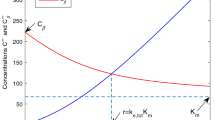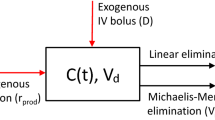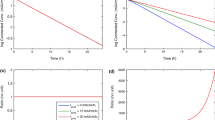Abstract
In this study, we aim to develop the analytical solutions of one-compartment pharmacokinetic models with sigmoidal Hill elimination and quantitatively revisit some widely used pharmacokinetic indexes. For this purpose, we have first established the closed-form solutions of the model with intravenous bolus administration through introducing a transcendent H function, which is proved a generalized form of the Lambert W function. Then, in the case of a single dose, we have obtained the explicit formulas for several pharmacokinetic surrogates, such as the clearance, elimination half-life and partial/total drug exposure. All these surrogates are found concentration-dependent and sensitive to the Hill coefficient \(\alpha \). Meanwhile, in establishing the closed-form formulas for multiple repeated dosing regimens, we have discovered phase transitions for steady states with different ranges of \(\alpha \) in function of the lengths of dosing intervals. Further, our results are illustrated with two drug examples. To conclude, the present findings elucidate the intrinsic quantitative structural properties of pharmacokinetic models with Hill elimination and provide new knowledge for nonlinear pharmacokinetics and guidance for rational drug designs.










Similar content being viewed by others
Data Availability
The datasets generated during and/or analyzed during the current study are available from the corresponding author on reasonable request.
Notes
\(C(t)=0\) for all \(t\ge T_1^*\) if \(0<\alpha <1\).
References
Ahmad YA, David JRF, Richard NU (2015) ADVAN-style analytical solutions for common pharmacokinetic models. J Pharmacol Toxicol Methods 73:42–48
Beal SL (1982) On the solution to the Michaelis–Menten equation. J Pharmacokinet Biopharm 10:109–119
Birrell GB, Zaikova TO, Rukavishnikov AV, Keana JF, Griffith OH (2003) Allosteric interactions within subsites of a monomeric enzyme: kinetics of fluorogenic substrates of PI-specific phospholipase C. Biophys J 84(5):3264–3275
Chitnis N, Hyman JM, Cushing JM (2008) Determining important parameters in the spread of malaria through the sensitivity analysis of a mathematical model. Bull Math Biol 70(5):1272–1296
Corless RM, Gonnet GH, Hare DEG, Jeffrey DJ, Knuth DE (1996) On the Lambert W function. Adv Comput Math 5:329–359
Fermín L, Lévy-Vehel J (2017) Variability and singularity arising from poor compliance in a pharmacokinetic model II: the multi-oral case. J Math Biol 74(4):809–841
Goličnik M (2012) On the Lambert W function and its utility in biochemical kinetics. Biochem Eng J 63:116–123
Goličnik M (2011) Explicit reformulations of the Lambert W-omega function for calculations of the solutions to one-compartment pharmacokinetic models with Michaelis-Menten elimination kinetics. Eur J Drug Metab Pharmacokinet 36:121
Goyal N (2015) The role of drug exposure in clinical development: To what extent is pharmacokinetic assessment needed in a drug development programme? Clin Pharmacokinet 54:985–987
Houston JB, Kenworthy KE (2000) In vitro-in vivo scaling of CYP kinetic data not consistent with the classical Michaelis–Menten model. Drug Metab Dispos 28(3):246–254
Konsil J, Dechasathian S, Mason DH Jr, Stevens RE (2002) Reanalysis of carbamazepine and carbamazepine-epoxide pharmacokinetics after multiple dosing of extended release formulation. J Pharm Pharm Sci 5(2):169–175
Lammert C, Bjornsson E, Niklasson A, Chalasani N (2010) Oral medications with significant hepatic metabolism at higher risk for hepatic adverse events. Hepatology 51(2):615–620
Lesko LJ (1979) Dose-dependent elimination kinetics of theophylline. Clin Pharmacokinet 4(6):449–459
Lévy Véhel P, Lévy Véhel J (2013) Variability and singularity arising from poor compliance in a pharmacokinetic model I: the multi-IV case. J Pharmacokinet Pharmacodyn 40(1):15–39
Li J, Nekka F (2007) A pharmacokinetic formalism explicitly integrating the patient drug compliance. J Pharmacokinet Pharmacodyn 34(1):115–139
Popović JK, Dolićanin D, Rapaić MR, Popović SL, Pilipović S, Atanacković TM (2011) A nonlinear two compartmental fractional derivative model. Eur J Drug Metab Pharmacokinet 36(4):189–196
Shargel L, Yu ABC (2016) Applied biopharmaceutics & pharmacokinetics, 7e. McGraw-Hill
Shou M, Mei Q, Ettore MW Jr, Dai R, Baillie TA, Rushmore TH (1999) Sigmoidal kinetic model for two co-operative substrate-binding sites in a cytochrome P450 3A4 active site: an example of the metabolism of diazepam and its derivatives. Biochem J 340:845–853
Sopasakis P, Sarimveis H, Macheras P et al (2018) Fractional calculus in pharmacokinetics. J Pharmacokinet Pharmacodyn 45:107–125
Tang S, Xiao Y (2007) One-compartment model with Michaelis–Menten elimination kinetics and therapeutic window: an analytical approach. J Pharmacokinet Pharmacodyn 34:807–827
Turino LN, Mariano RN, Cabrera MI, Scándolo DE, Maciel MG, Grau RJ (2010) Pharmacokinetics of progesterone in lactating dairy cows: gaining some insights into the metabolism from kinetic modeling. J Dairy Sci 93(3):988–999
Wagner JG (1973) Properties of the Michaelis–Menten equation and its integrated form which are useful in pharmacokinetics. J Pharmacokinet Biopharm 1(2):103–121
Wilkinson PK, Sedman AJ, Sakmar E, Kay DR, Wagner JG (1977) Pharmacokinetics of ethanol after oral administration in the fasting state. J Pharmacokinet Biopharm 5(3):207–224
Wong H, Tong V, Riggs KW, Rurak DW, Abbott FS, Kumar S (2007) Kinetics of valproic acid glucuronidation: evidence for in vivo autoactivation. Drug Metab Dispos 35(8):1380–6
Wong H, Xia B, Tong V, Kumar S, Kenny J (2012) Atypical kinetics of valproic acid glucuronidation in vitro and in vivo in humans. Pharmaceutica Analytica Acta 1–5
Wu X, Li J, Nekka F (2015) Closed form solutions and dominant elimination pathways of simultaneous first-order and Michaelis–Menten kinetics. J Pharmacokinet Pharmacodyn 42:151–161
Wu X, Nekka F, Li J (2018) Mathematical analysis and drug exposure evaluation of pharmacokinetic models with endogenous production and simultaneous first-order and Michaelis–Menten elimination: the case of single dose. J Pharmacokinet Pharmacodyn 45(5):693–705
Wu X, Nekka F, Li J (2019) Analytical solution and exposure analysis of a pharmacokinetic model with simultaneous elimination pathways and endogenous production: the case of multiple dosing administration. Bull Math Biol 81:3436–3459
Wu X, Chen M, Li J (2021) Constant infusion case of one compartment pharmacokinetic model with simultaneous first-order and Michaelis–Menten elimination: analytical solution and drug exposure formula. J Pharmacokinet Pharmacodyn 48(4):495–508
Yadav J, Korzekwa K, Nagar S (2021) Numerical methods for modeling enzyme kinetics. Methods Mol Biol 2342:147–168
Acknowledgements
X. Wu thanks the financial support from National Natural Science Foundation of China (Nos. 12271346, 12071300), and J. Li thanks the supports from Natural Sciences and Engineering Research Council of Canada (Grant No. RGPIN-2016-05058) and the Fonds de recherche du Québec—Nature et technologies (FRQNT). We would also like to thank two anonymous reviewers for their helpful and insightful comments which lead to the high improvement of the article’s quality.
Author information
Authors and Affiliations
Corresponding author
Additional information
Publisher's Note
Springer Nature remains neutral with regard to jurisdictional claims in published maps and institutional affiliations.
Appendices
Appendix A: Proof of Remark 3
From Eq. (24), if \(0<\alpha <2\), \(\mathrm{AUC}_{0-\infty }\) can be rewritten as
Using the fact \(\ln (1+x)\approx x\) for x close to zero, we have \(\ln \frac{D}{V_\mathrm{d}}=\ln (1+(\frac{D}{V_\mathrm{d}}-1))\approx (\frac{D}{V_\mathrm{d}}-1)\) for a low enough D. Doing the Taylor series expansion on D, we have
However, for a large enough D, we can deduce from Eq. (24) that \(\mathrm{AUC}_{0-\infty }\) is predominantly determined by the quadratic term w.r.t. D, namely \(\frac{1}{2V_{\mathrm{max}}}(\frac{D}{V_\mathrm{d}})^2\). When \(\alpha =1\), we have calculated \(\mathrm{AUC}_{0-\infty }=\frac{K_\mathrm{D}}{V_{\mathrm{max}}}\frac{D}{V_\mathrm{d}}+\frac{1}{2V_{\mathrm{max}}}(\frac{D}{V_\mathrm{d}})^2\), which is also predominantly determined by the latter term \(\frac{1}{2V_{\mathrm{max}}}(\frac{D}{V_\mathrm{d}})^2\) for a large enough dose D.
Appendix B: Sensitivity Indices Calculation
-
(i)
By Definition (27) and Eq. (5), the sensitivity index of C(t) to \(\alpha \) is \(\lambda ^{C(t)}_{\alpha }=\frac{\partial C(t)}{\partial \alpha }\frac{\alpha }{C(t)}\), and
$$\begin{aligned} \frac{\partial C(t)}{\partial \alpha }= & {} \frac{K_\mathrm{D}^{\alpha }}{1-\alpha }\left[ \left( C_0^{1-\alpha }-C^{1-\alpha }(t)\right) \left( \frac{1}{1-\alpha }+\ln K_\mathrm{D}\right) \right. \nonumber \\&\quad \left. -\, \left( C_0^{1-\alpha }\ln C_0-C^{1-\alpha }(t)\ln C(t)\right) \right] . \end{aligned}$$(38) -
(ii)
From Eq. (17), the sensitivity index of \(T_{1/2}\) to \(\alpha \) is \(\lambda ^{ T_{1/2}}_{\alpha }=\frac{\partial T_{1/2}}{\partial \alpha }\frac{\alpha }{ T_{1/2}}\), and
$$\begin{aligned} \frac{\partial T_{1/2}}{\partial \alpha }&= \frac{K_\mathrm{D}}{(\alpha -1)V_{\max }}\left( \frac{K_\mathrm{D}}{C(t)}\right) ^{\alpha -1} \left[ 2^{\alpha -1}\ln 2-\frac{2^{\alpha -1}-1}{\alpha -1}+(2^{\alpha -1}-1)\ln \frac{K_\mathrm{D}}{C(t)}\right] \nonumber \\&\quad +\, \left[ \frac{1}{2V_{\max }}-\frac{2^{\alpha -1}-1}{V_{\max }}\left( \frac{K_\mathrm{D}}{C(t)}\right) ^{\alpha }\right] \frac{\partial C(t)}{\partial \alpha }. \end{aligned}$$(39) -
(iii)
From Eq. (25), the sensitivity indices of \(\mathrm{AUC}_{0-\infty }\) to model parameters are
$$\begin{aligned} \lambda _{\alpha }^{\mathrm{AUC}_{0-\infty }}&=\left( \frac{\alpha }{2-\alpha }+\alpha \ln \frac{K_\mathrm{D}}{C_0}\right) \Big /\left( 1+\frac{2-\alpha }{2}\left( \frac{C_0}{K_\mathrm{D}}\right) ^{\alpha }\right) , \end{aligned}$$(40)$$\begin{aligned} \lambda _{V_{\max }}^{\mathrm{AUC}_{0-\infty }}&=-1, \end{aligned}$$(41)$$\begin{aligned} \lambda _{K_\mathrm{D}}^{\mathrm{AUC}_{0-\infty }}&=\alpha \Big /\left( 1+\frac{2-\alpha }{2}\left( \frac{C_0}{K_\mathrm{D}}\right) ^{\alpha }\right) , \end{aligned}$$(42)$$\begin{aligned} \lambda _{V_\mathrm{d}}^{\mathrm{AUC}_{0-\infty }}&= (\alpha -2)\times \left( 1+\left( \frac{C_0}{K_\mathrm{D}}\right) ^{\alpha }\right) \Big /\left( 1+\frac{2-\alpha }{2}\left( \frac{C_0}{K_\mathrm{D}}\right) ^{\alpha }\right) . \end{aligned}$$(43)
Appendix C: Proof of Lemma 1
Proof
First, we assume Eq. (29) has a fixed point. As a sequence \(\{C_{\max ,n}\}_{n=1}^{\infty }\) is non decreasing, we denote \(C^{ss}_{\max }=\lim \limits _{n\rightarrow \infty }C_{\max ,n}>D/V_\mathrm{d}\). Following the definition of H(s) (Eq. (8)), we have
which can be simplified as
Consider the function \(g:[D/V_\mathrm{d},\infty ) \longrightarrow \mathbb {R}\); \(g(x)=x^{1-\alpha }-(x-D/V_\mathrm{d})^{1-\alpha }\), whose derivative is
We can notice that, for all positive \(\alpha \not =1\), \(\displaystyle \frac{1}{x^{\alpha }}<\frac{1}{(x-D/V_\mathrm{d})^{\alpha }}\) if \(x>D/V_\mathrm{d}\). So, on \([D/V_\mathrm{d},\infty )\), g(x) is monotonically decreasing for \(0<\alpha <1\) as \(g'(x)<0\), and monotonically increasing for \(\alpha >1\) as \(g'(x)>0\).
Now, we discuss the asymptotic property of \(C_{\max ,n}\).
-
(i)
\(0<\alpha <1\). In this case, \(g(D/V_\mathrm{d})=(D/V_\mathrm{d})^{1-\alpha }>0\) and \(\lim \nolimits _{x\rightarrow +\infty }g(x)=0\). It indicates that g(x) monotonically decreases from \((D/V_\mathrm{d})^{1-\alpha }\) to 0, which conversely implies that Eq. (29) has a unique fixed point \(C^{ss}_{\max }\) larger than \(D/V_\mathrm{d}\) if and only if
$$\begin{aligned} 0<\frac{V_{\max }(1-\alpha )}{K_\mathrm{D}^{\alpha }}\left( T-\frac{D}{V_\mathrm{d}V_{\max }}\right) <\left( \frac{D}{V_\mathrm{d}}\right) ^{1-\alpha }, \end{aligned}$$(46)or
$$\begin{aligned} T_0^*=\frac{D}{V_\mathrm{d}V_{\max }}<T<\frac{D}{V_\mathrm{d}V_{\max }}\left( 1+\frac{1}{1-\alpha }\left( \frac{K_\mathrm{D}}{D/V_\mathrm{d}}\right) ^{\alpha }\right) =T_1^*. \end{aligned}$$(47)Otherwise, \(C_{\max ,n}\) will continue to increase if \(T<T_0^*\), or \(C_{\min ,n}=0\) and \(C_{\max ,n}=D/V_\mathrm{d}\) for all n if \(T>T_1^*\). Particularly,
$$\begin{aligned} \lim \limits _{\alpha \rightarrow 1^-}\frac{D}{V_\mathrm{d}V_{\max }}\left( 1+\frac{1}{1-\alpha }\left( \frac{K_\mathrm{D}}{D/V_\mathrm{d}}\right) ^{\alpha }\right) =+\infty \end{aligned}$$which is consistent with the condition of the existence of \(C^{ss}_{\max }\) for one-compartment pharmacokinetic model with a single Michaelis–Menten elimination pathway (Tang and Xiao 2007).
-
(ii)
\(\alpha >1\). In this case, we have \(\lim \nolimits _{t\rightarrow (D/V_\mathrm{d})^+}g(x)=-\infty \) and \(\lim \nolimits _{t\rightarrow +\infty }g(x)=0\). This indicates that g(x) monotonically increases from negative infinity to zero as x goes up from \(D/V_\mathrm{d}\) to \(+\infty \). Subsequently, Eq. (29) has a unique fixed point \(C^{ss}_{\max }\) which is greater than \(D/V_\mathrm{d}\) if and only if
$$\begin{aligned} \frac{1-\alpha }{K_\mathrm{D}^{\alpha }}\left( V_{\max }T-\frac{D}{V_\mathrm{d}}\right) <0\Leftrightarrow T>\frac{D}{V_\mathrm{d}V_{\max }}=T_0^*. \end{aligned}$$
Rights and permissions
Springer Nature or its licensor holds exclusive rights to this article under a publishing agreement with the author(s) or other rightsholder(s); author self-archiving of the accepted manuscript version of this article is solely governed by the terms of such publishing agreement and applicable law.
About this article
Cite this article
Wu, X., Zhang, H. & Li, J. An Analytical Approach of One-Compartmental Pharmacokinetic Models with Sigmoidal Hill Elimination. Bull Math Biol 84, 117 (2022). https://doi.org/10.1007/s11538-022-01078-4
Received:
Accepted:
Published:
DOI: https://doi.org/10.1007/s11538-022-01078-4
Keywords
- Pharmacokinetic models
- Sigmoidal Hill elimination
- Closed-form solution
- Transcendent function
- Pharmacokinetic surrogates




